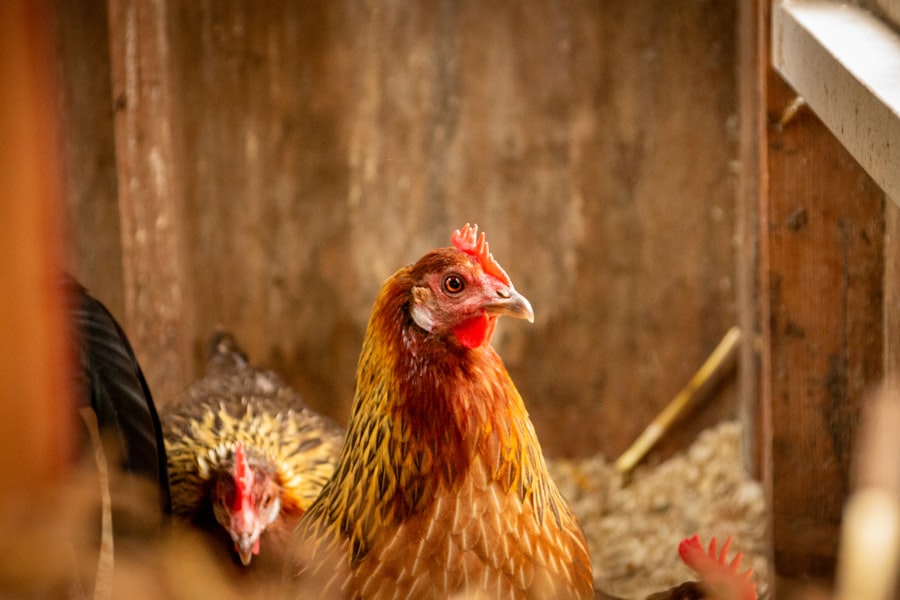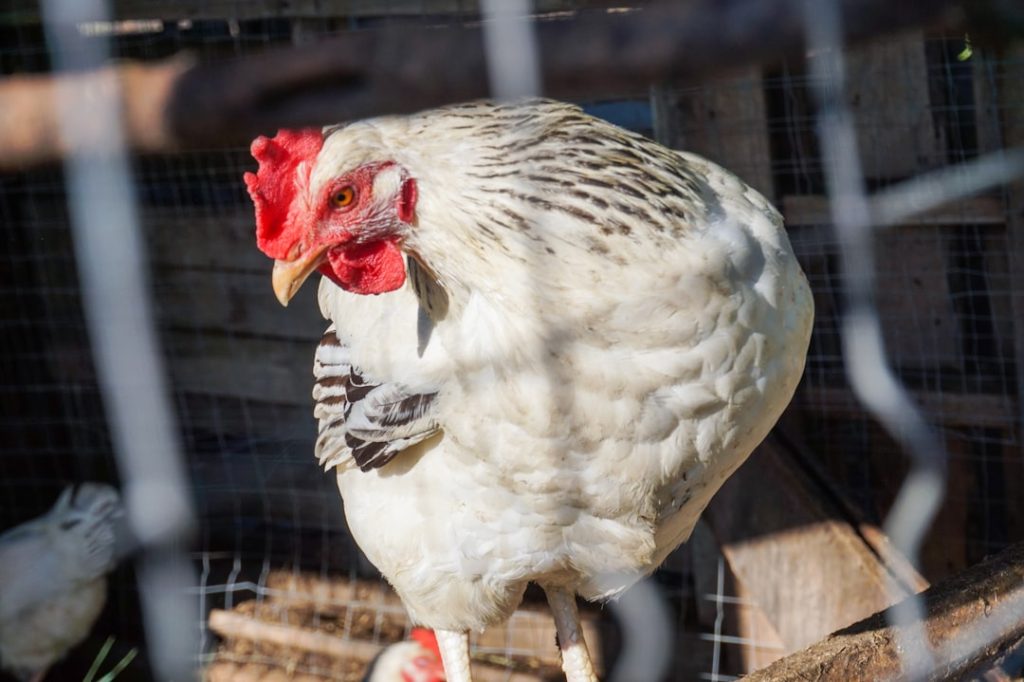When raising chickens, understanding their space requirements is essential. Chickens require adequate space to move, stretch their wings, and engage in natural behaviors such as scratching and dust bathing. The recommended space allocation is 2-3 square feet per chicken inside the coop and 8-10 square feet per chicken in an outdoor run.
This allocation helps prevent aggression and pecking within the flock by providing sufficient room for movement. Nesting boxes and roosting perches are also crucial components of chicken housing. One nesting box should be provided for every 3-4 hens to ensure they have a comfortable place to lay eggs.
Roosting perches are necessary for chickens to sleep at night, and there should be enough space for each bird to roost without overcrowding. Chickens are social creatures that benefit from environments allowing them to express natural behaviors and establish a social hierarchy. Providing appropriate space is vital for their health, happiness, and productivity.
By meeting these space requirements, chicken owners can create an optimal environment for their flock.
Table of Contents
- 1 Calculating the Ideal Number of Chickens for an 8×8 Coop
- 2 Considering the Breeds and Sizes of Chickens
- 3 Factors to Consider for the Health and Well-being of Chickens
- 4 Implementing Proper Roosting and Nesting Arrangements
- 5 Providing Adequate Ventilation and Light in the Coop
- 6 Maintaining Cleanliness and Hygiene in the Coop for the Chickens’ Comfort
- 7 FAQs
- 7.1 1. How many chickens can comfortably fit in an 8×8 coop?
- 7.2 2. What factors should be considered when determining the number of chickens for an 8×8 coop?
- 7.3 3. Are there any regulations or guidelines for the number of chickens in a coop?
- 7.4 4. What are the potential issues of overcrowding chickens in a coop?
- 7.5 5. How can I maximize space in an 8×8 coop for chickens?
Key Takeaways
- Chickens require at least 2-3 square feet of space per bird in the coop to ensure they have enough room to move around and exhibit natural behaviors.
- For an 8×8 coop, the ideal number of chickens would be around 16-20 standard-sized birds or 24-32 bantam-sized birds, taking into account the space requirements and allowing for adequate ventilation and nesting space.
- When considering breeds and sizes of chickens, it’s important to factor in the climate, available space, and desired egg production, as well as the temperament and compatibility of different breeds.
- Factors to consider for the health and well-being of chickens include providing a balanced diet, access to clean water, regular health check-ups, and protection from predators and extreme weather conditions.
- Proper roosting and nesting arrangements are essential for chickens’ comfort and egg-laying behavior, with at least 8-10 inches of roosting space per bird and one nesting box for every 3-4 hens.
- Adequate ventilation and light in the coop are crucial for maintaining good air quality, regulating temperature, and supporting the chickens’ natural circadian rhythms and egg production.
- Maintaining cleanliness and hygiene in the coop, including regular removal of droppings, replacing bedding, and disinfecting waterers and feeders, is essential for preventing disease and ensuring the chickens’ comfort and well-being.
Calculating the Ideal Number of Chickens for an 8×8 Coop
When determining the ideal number of chickens for an 8×8 coop, it’s essential to consider the space requirements mentioned earlier. With the recommended 2-3 square feet of space per chicken inside the coop, an 8×8 (64 square feet) coop can comfortably accommodate 21-32 chickens. However, it’s important to keep in mind that this calculation is based solely on the space available inside the coop and does not account for outdoor run space.
If the coop is connected to an outdoor run, the total space available for the chickens increases, allowing for a larger flock. With an outdoor run providing 8-10 square feet per chicken, the 8×8 coop can support a flock of 64-80 chickens when considering both indoor and outdoor space. It’s crucial to avoid overcrowding, as this can lead to stress, aggression, and a higher risk of disease within the flock.
Ultimately, the ideal number of chickens for an 8×8 coop will depend on whether the birds have access to an outdoor run, their individual space requirements, and the owner’s management capabilities. By carefully calculating the space available and considering the needs of the chickens, owners can ensure that their flock is comfortable and healthy.
Considering the Breeds and Sizes of Chickens

When it comes to choosing breeds and sizes of chickens for a coop, there are several factors to consider. Different chicken breeds have varying space requirements, temperaments, egg-laying capabilities, and overall sizes. Some breeds are larger and more active, requiring more space to move around, while others are smaller and more docile, making them suitable for coops with limited space.
For smaller coops, bantam breeds are a popular choice due to their compact size and friendly disposition. Bantams require less space than standard-sized chickens and are known for being excellent layers despite their small stature. On the other hand, larger coops can accommodate standard-sized breeds such as Rhode Island Reds, Orpingtons, and Australorps, which are prized for their egg-laying abilities and hardy nature.
In addition to considering breed size, it’s important to think about the number of chickens needed to meet egg production goals. Some breeds are prolific layers, while others may lay fewer eggs but are valued for their meat quality or ornamental appeal. By carefully considering the breeds and sizes of chickens for a coop, owners can create a harmonious flock that meets their specific needs and preferences.
Factors to Consider for the Health and Well-being of Chickens
Maintaining the health and well-being of chickens is paramount for any poultry owner. Several factors contribute to the overall health of a flock, including nutrition, disease prevention, parasite control, and environmental enrichment. Providing a balanced diet rich in essential nutrients is crucial for supporting the immune system and promoting optimal growth and egg production in chickens.
In addition to nutrition, disease prevention is a key consideration for maintaining chicken health. Regular vaccinations, biosecurity measures, and proper sanitation practices can help prevent common poultry diseases such as Marek’s disease, coccidiosis, and infectious bronchitis. Furthermore, controlling parasites such as mites, lice, and worms is essential for preventing discomfort and illness in chickens.
Environmental enrichment is another important factor in promoting the well-being of chickens. Enriching the coop with perches, dust bathing areas, and toys can reduce stress and boredom in the flock, leading to healthier and happier birds. By considering these factors and implementing appropriate measures, poultry owners can ensure that their chickens remain healthy and thriving.
Implementing Proper Roosting and Nesting Arrangements
Proper roosting and nesting arrangements are essential for ensuring the comfort and well-being of chickens in a coop. Roosting perches should be elevated off the ground to provide a safe and comfortable place for chickens to rest at night. The perches should be wide enough for the birds to grip with their feet and positioned at a height that allows them to easily access them without feeling cramped or crowded.
Nesting boxes are equally important for providing a suitable environment for hens to lay their eggs. The boxes should be placed in a quiet and secluded area of the coop to provide privacy and reduce disturbances during egg-laying. Each nesting box should be lined with clean bedding material such as straw or wood shavings to create a cozy and inviting space for the hens.
By implementing proper roosting and nesting arrangements, poultry owners can ensure that their chickens have a safe and comfortable environment for resting and laying eggs. These arrangements also contribute to overall flock health by reducing stress and promoting natural behaviors in the birds.
Providing Adequate Ventilation and Light in the Coop

Adequate ventilation and light are crucial elements in maintaining a healthy and comfortable environment for chickens in a coop. Proper ventilation helps remove excess moisture, ammonia, and airborne pathogens from the air, reducing the risk of respiratory issues and promoting overall respiratory health in the flock. Ventilation openings should be strategically placed to allow for fresh air circulation without creating drafts that could cause discomfort to the birds.
In addition to ventilation, providing adequate light is important for regulating the chickens’ circadian rhythms and promoting egg production. Natural light from windows or skylights can help maintain a consistent day-night cycle for the birds, while supplemental lighting can be used during shorter daylight periods to encourage continued egg laying. It’s important to strike a balance with lighting to ensure that chickens receive enough light without causing unnecessary stress or disruption to their natural behavior.
By prioritizing adequate ventilation and light in the coop, poultry owners can create a healthy and comfortable living environment for their chickens. These measures contribute to overall flock well-being by reducing respiratory issues, regulating circadian rhythms, and supporting consistent egg production.
Maintaining Cleanliness and Hygiene in the Coop for the Chickens’ Comfort
Maintaining cleanliness and hygiene in the coop is essential for ensuring the comfort and well-being of chickens. Regular cleaning of bedding material, nesting boxes, roosting perches, and coop surfaces helps prevent the buildup of waste, bacteria, and parasites that can lead to disease and discomfort in the flock. Bedding material should be replaced regularly to keep it dry and odor-free, while nesting boxes should be cleaned out to provide a clean environment for egg-laying hens.
In addition to regular cleaning, proper waste management is crucial for maintaining cleanliness in the coop. Dropping boards or trays placed beneath roosting perches can help collect droppings for easy removal, reducing ammonia levels and minimizing odors in the coop. Outdoor runs should also be regularly cleaned to prevent waste buildup and maintain a healthy environment for free-ranging chickens.
By prioritizing cleanliness and hygiene in the coop, poultry owners can create a comfortable living environment that supports overall flock health and well-being. These measures contribute to disease prevention, parasite control, and reduced stress in the birds, ultimately leading to happier and more productive chickens.
If you’re wondering how many chickens you can keep in an 8×8 coop, you may want to check out this article on Poultry Wizard. It provides helpful tips and guidelines for determining the appropriate number of chickens for your coop size.
FAQs
1. How many chickens can comfortably fit in an 8×8 coop?
Generally, you can comfortably house 10-15 standard size chickens in an 8×8 coop. However, the exact number may vary based on the breed, size of the chickens, and local regulations.
2. What factors should be considered when determining the number of chickens for an 8×8 coop?
When determining the number of chickens for an 8×8 coop, factors such as the size of the chickens, their breed, local climate, ventilation, and access to outdoor space should be taken into consideration.
3. Are there any regulations or guidelines for the number of chickens in a coop?
Local regulations and guidelines may vary, so it’s important to check with your local agricultural extension office or zoning department to ensure compliance with any regulations regarding the number of chickens allowed in a coop.
4. What are the potential issues of overcrowding chickens in a coop?
Overcrowding can lead to stress, aggression, and an increased risk of disease among the chickens. It can also result in poor egg production and overall health of the flock.
5. How can I maximize space in an 8×8 coop for chickens?
To maximize space in an 8×8 coop, consider using vertical space with roosts and nesting boxes, providing ample outdoor space for the chickens to roam, and ensuring good ventilation and cleanliness within the coop.
Meet Walter, the feathered-friend fanatic of Florida! Nestled in the sunshine state, Walter struts through life with his feathered companions, clucking his way to happiness. With a coop that’s fancier than a five-star hotel, he’s the Don Juan of the chicken world. When he’s not teaching his hens to do the cha-cha, you’ll find him in a heated debate with his prized rooster, Sir Clucks-a-Lot. Walter’s poultry passion is no yolk; he’s the sunny-side-up guy you never knew you needed in your flock of friends!







